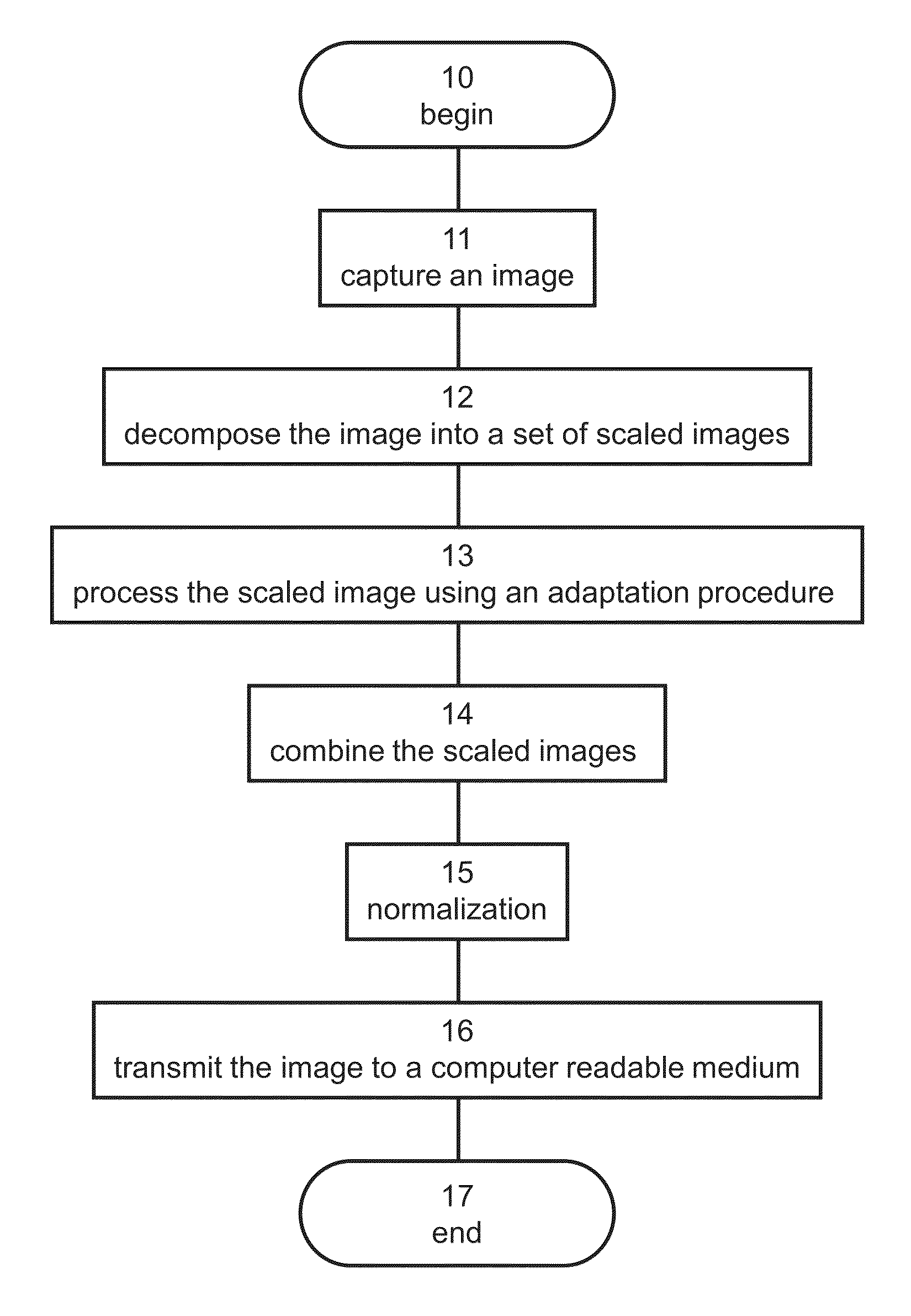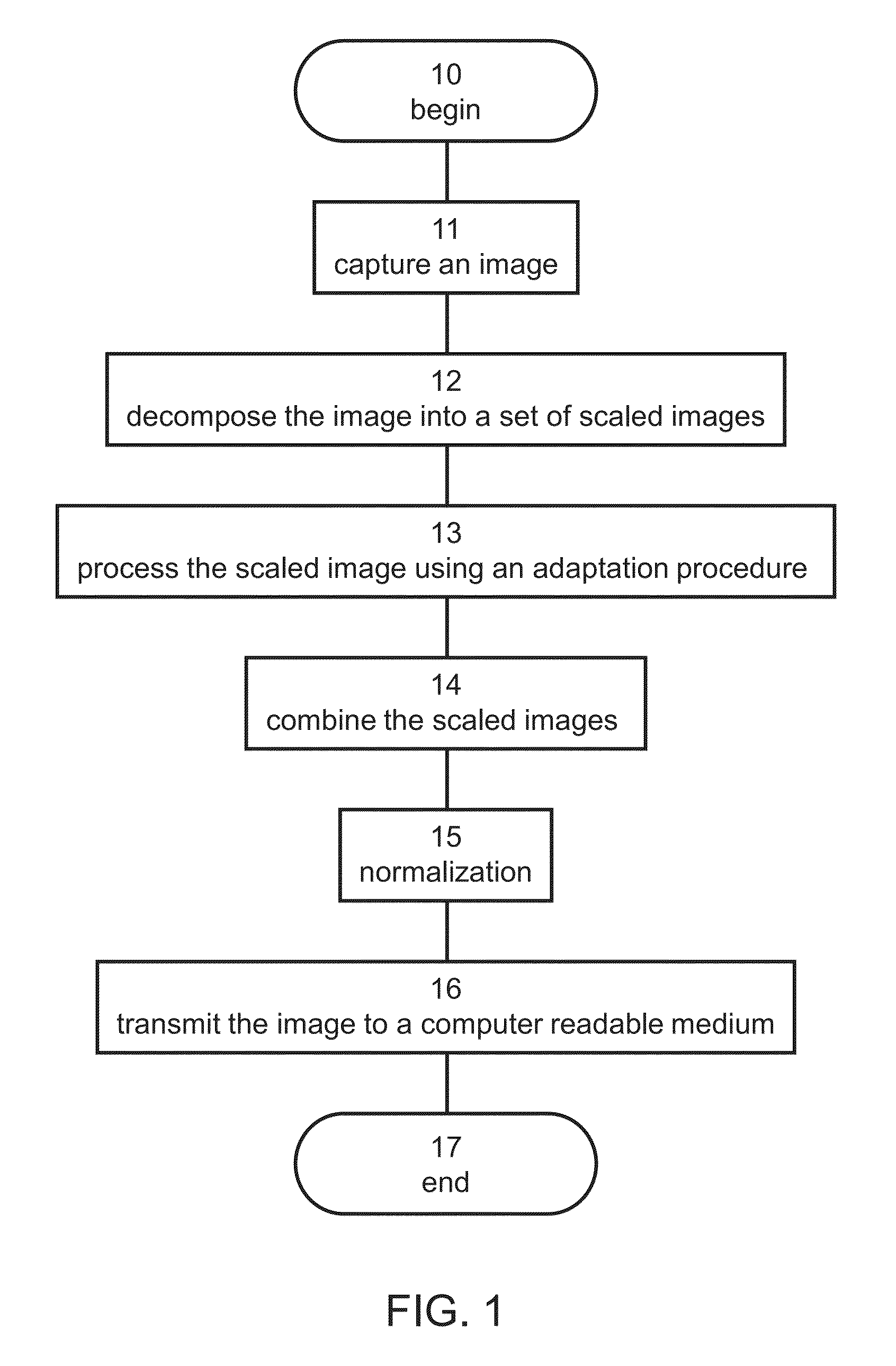Method and system for processing an image featuring multiple scales
a technology of image and scale, applied in the field of image processing, can solve the problems of aggravated problems and substantial loss of images
- Summary
- Abstract
- Description
- Claims
- Application Information
AI Technical Summary
Benefits of technology
Problems solved by technology
Method used
Image
Examples
example 1
Thermal Images
[0165]The technique of the present embodiments was employed to process thermal images acquired using an infrared camera. FIGS. 6A, 7A, 8A, 9A, 10A and 11A show the original images, before processing. Each image was processed according to some embodiments of the present invention as described in the flowchart of FIG. 1. The image was decomposed into 3 scaled images each of which was processed using EQs. 1, 2, 4, 5 and 7-14. The modulation coefficient was set to 1.
[0166]For the contrast-based adaptation procedure, up to six possible resolutions were employed. The application of the specific resolution was done such that the coarse resolution was applied to the overall scales for the whole image. In other word, fine resolution in the SORF were not included in the coarse general scales. Table 1 specifies the radii of the center and surround regions which were used for each resolution k.
[0167]
TABLE 1kradius of the center regionradius of the surround region113239351547125927...
example 2
HDR Images
[0169]Embodiments of the present invention were applied to High Dynamic Range images in an RGBE format. The original HDR images were obtained through the courtesy of Michael Werman, Erik Reinhard, Greg Ward, SpheronVR AG, Munsell Color Science Laboratory, and Paul Debevec's website.
[0170]Achromatic intensities were extracted from the polychromatic data of the images. This was performed by transforming each pixel in the RGBE image to CIE XYZ using the D65 sRGB transform matrix [IEC 61966-2-1:1999]. The achromatic intensity of each pixel was defined as the Y value of the pixel. Further transformation from the CIE XYZ space to CIE xyz was performed for each pixel, and the x,z, values were applied to the new achromatic intensities yielded according to various exemplary embodiments of the present invention.
[0171]Each image was processed according to some embodiments of the present invention as described in the flowchart of FIG. 1. The image was decomposed into 4 scaled images e...
example 3
Optimization Considerations
[0174]A multi-resolution representation of an image I, referred to below as “the artist” image was produced according to some embodiments of the present invention using a Reduce operation featuring Gaussian weights, thereby forming a Gaussian pyramid. The process was applied as follows:
Bn=Reduce(Bn−1), (EQ. 16)
where the finest resolution B0 was set to be the original image:
B0=I. (EQ. 17)
[0175]The obtained Gaussian pyramid for a set of six scaled images I0, . . . , I5 is shown in FIGS. 13A-F.
[0176]A relative luminance qn was then calculated according to the relation:
qn=In / In+1, (EQ. 18)
where In is the nth scaled image and In+1 is an interpolated version of the n+1 scaled image obtained using the Expand operator:
In=Bn
In+1=Expand(Bn+1) (EQ. 19)
[0177]The calculation of relative luminance resulted in a luminance pyramid corresponding to the relative luminance levels q0, . . . , q4, shown in FIGS. 14A-E.
[0178]Once the luminance pyramid was obtained, a local...
PUM
 Login to View More
Login to View More Abstract
Description
Claims
Application Information
 Login to View More
Login to View More - R&D
- Intellectual Property
- Life Sciences
- Materials
- Tech Scout
- Unparalleled Data Quality
- Higher Quality Content
- 60% Fewer Hallucinations
Browse by: Latest US Patents, China's latest patents, Technical Efficacy Thesaurus, Application Domain, Technology Topic, Popular Technical Reports.
© 2025 PatSnap. All rights reserved.Legal|Privacy policy|Modern Slavery Act Transparency Statement|Sitemap|About US| Contact US: help@patsnap.com



